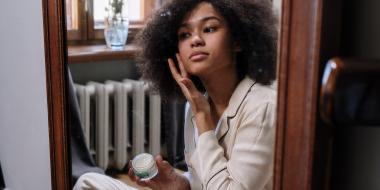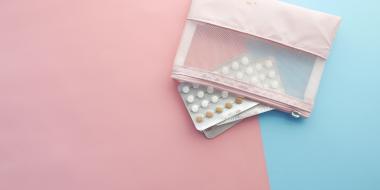In the many years that I have been in the non-toxic skincare industry, there is one group of people that I have never had much success selling to, and that’s teenagers. I’m not entirely sure why, but I think it has something to do with price point, packaging, and general apathy. It’s typical for this age group to answer the question, “What do you use on your skin?” with “I don’t know,” which leads me to believe that either their parents are purchasing these items for them, or they are mindlessly grabbing whatever they are drawn to off of drugstore shelves. They don’t seem to put much thought into the safety of the ingredients that they are putting on their skin. This concerns me because of all the age groups, teens absolutely should care.
Why should teens care about cosmetics?
Adolescence is a pivotal time in the growth of the human body. Hormones within the endocrine system are working double-time to develop the reproductive system, the brain, bones, blood, and immune system. It’s a delicate balance that can easily be harmed by exposure to the wrong chemicals. Chemicals that interfere with regular hormonal functioning are called “endocrine disrupting chemicals” (EDCs) and the likelihood that a teenager is exposing themselves to these substances on a daily basis is extremely high, given that they are present in thousands of personal care products on the market. The Environmental Working Group in the United States tested the blood and urine of 20 teens aged 14-19 and found an average of 13 different EDCs in the form of parabens, triclosan, synthetic musks and phthalates.
EDCs are not just in personal care products, they’re everywhere; biomonitoring has found them in 100% of humans tested. The World Health Organization recently released a report about these chemicals because we are seeing an alarming increase in what are called “modern diseases,” namely autoimmune disorders and cancers. The link between these diseases and EDCs is becoming glaringly obvious. The self-regulated personal care industry has been formulating with toxic cosmetic ingredients for years because their traditional safety testing has never considered a chemical’s effect on hormones. Any moves to legislate new safety standards are met with strong opposition from the very powerful conglomerates that produce these chemicals.
Things to look for in teen personal products
Like so many other consumer goods, the responsibility is in the hands of teens and their parents to keep EDCs out of their bodies by reading cosmetic labels and researching ingredients in places like EWG's Skin Deep database. To get you started, here is a list of common problem ingredients to look out for in teen personal care products.
Perfume and cologne
Perfumes and colognes promise that smelling good will make you more sexually attractive, so is it any wonder that teenagers are buying these products? They are marketing directly to them, with celebrity names adorning their bottles. Mostly made of synthetic fragrance, perfumes and colognes do not have to list their ingredients for proprietary reasons. There are so many dangerous chemicals in these products that I consider fragrance the worst offender in the entire industry. Of the 17 most popular perfumes analyzed by the Environmental Working Group, all of them contained synthetic musks and 12 contained diethyl phthalate; both of these are proven endocrine disruptors.
What to avoid in scents
Avoid perfumes, colognes and other products that contain synthetic fragrance. Many places don't welcome scents any longer (no wonder), but if you must have a dab of something fragrant, look for natural perfumes.
Skin care
The skin care needs of teenagers are very different from those of adults. Their routine has little to do with fighting wrinkles and everything to do with fighting pimples. There are several commercial brands that target this issue and market directly to teens. The formulas usually contain an active (medicinal) ingredient in a base of chemicals. Acne can be tackled naturally with a clean diet, gentle exfoliant, and medicinal ingredients such as tea tree oil and witch hazel distillate.
Skincare ingredients to avoid
Ingredients to avoid are benzyl salicylate, resorcinol, parabens (methylparaben, propylparaben, ethylparaben, butylparaben, isobutylparaben), fragrance, butylated hydroxytoluene (BHT), and triclosan (can be found in anything labelled “antibacterial”).
Makeup
Teenagers are especially self-conscious of their looks, so makeup naturally becomes a staple to cover up perceived imperfections and enhance features on the face. Often the foundations that they choose can contribute to the very acne that it is supposed to be covering up! I recommend using a mineral-based powder for coverage, because it lets the skin breathe. Remember to wash makeup brushes regularly with gentle soap and water.
Ingredients to avoid in makeup
The ingredients to watch out for in colour cosmetics are parabens, BHT, fragrance and benzyl benzoate.
Sun care
Teenagers should absolutely protect themselves from the sun because the damage they do now can last a lifetime. Chemicals sunscreens convert UV rays to heat and can inflame skin, so I wouldn’t recommend this for the acne-prone. Physical sunscreens that deflect light such as zinc or titanium oxide are a much better option.
Sun care ingredients to avoid
The EDCs to avoid in sunscreen are oxybenzone, octinoxate and homosalate.
Deodorant and antiperspirants
I completely understand the desire to reduce body odour, and this can be a hard one. The armpits contain a group of lymph glands that excrete toxins as an important bodily cleansing function. Conventional underarm products strive to stop this process and contain toxic ingredients that should not be entering this vulnerable area.
A better way to tackle odour is to allow sweating but fight the bacteria it creates. Look for a good natural spray with magnesium and essential oils.
Deodorant ingredients to avoid
Avoid deodorants that contain fragrance, triclosan, BHT or parabens, and stay away from antiperspirants all together.
Lotions and hand soap
I don’t want to name any companies here, but there is a particular chain of body care products that has been cropping up in every mall in Canada in the last few years. Whenever I pass by it, I can see teenagers lined up for purchases. The packaging is cute and pretty and people love having the hand soap in their bathrooms. I had to use it once at a friend’s house and couldn’t get the lingering scent off my hands for a couple of days. This should tell you something about the wacky chemicals that are used!
Ingredients to avoid in lotions and soaps
The ingredients to look for in soaps, lotions and balms are very similar to the skincare list – avoid fragrance, parabens, BHT, and triclosan.
Take a pass on toxins, pass it on!
The teenage years are a difficult time to adjust to (for everyone involved). Using products that work against them is the last thing they need. Unfortunately this is what is being sold to them but fortunately, it's never too late to switch to a healthier regime. It’s time that teenagers became more aware of the health impacts of the products that they are putting on their bodies and how it can affect them in the long run.
If you are a teenager reading this, I commend you for gaining awareness about this issue. If you are a parent of a teen or know one, please pass this information along. Until the cosmetics and body care industries face more stringent controls, we must protect ourselves by building greater awareness of the risks we might otherwise unwittingly be exposed to.
*Originally published January 20, 2016






